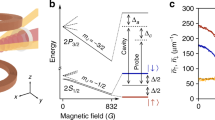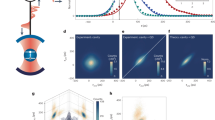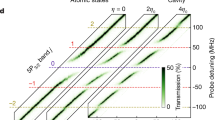Abstract
Cavity quantum electrodynamics (QED) manipulates the coupling of light with matter, and allows several emitters to couple coherently with one light mode1. However, even in a many-body system, the light–matter coupling mechanism has so far been restricted to one-body processes. Leveraging cavity QED for the quantum simulation of complex, many-body systems has thus far relied on multi-photon processes, scaling down the light–matter interaction to the low energy and slow time scales of the many-body problem2,3,4,5. Here we report cavity QED experiments using molecular transitions in a strongly interacting Fermi gas, directly coupling cavity photons to pairs of atoms. The interplay of strong light–matter and strong interparticle interactions leads to well-resolved pair polaritons—hybrid excitations coherently mixing photons, atom pairs and molecules. The dependence of the pair-polariton spectrum on interatomic interactions is universal, independent of the transition used, demonstrating a direct mapping between pair correlations in the ground state and the optical spectrum. This represents a magnification of many-body effects by two orders of magnitude in energy. In the dispersive regime, it enables fast, minimally destructive measurements of pair correlations, and opens the way to their measurement at the quantum limit and their coherent manipulation using dynamical, quantized optical fields.
This is a preview of subscription content, access via your institution
Access options
Access Nature and 54 other Nature Portfolio journals
Get Nature+, our best-value online-access subscription
$29.99 / 30 days
cancel any time
Subscribe to this journal
Receive 51 print issues and online access
$199.00 per year
only $3.90 per issue
Buy this article
- Purchase on Springer Link
- Instant access to full article PDF
Prices may be subject to local taxes which are calculated during checkout




Similar content being viewed by others
Data availability
All data files are available from the corresponding author upon request. Accompanying data, including those for figures, are available from the Zenodo repository (https://doi.org/10.5281/zenodo.489675710.5281/zenodo.4896757).
References
Haroche, S. & Raimond, J.-M. Exploring the Quantum: Atoms, Cavities, and Photons (Oxford Univ. Press, 2006).
Klinder, J., Keßler, H., Bakhtiari, M. R., Thorwart, M. & Hemmerich, A. Observation of a superradiant mott insulator in the dicke-hubbard model. Phys. Rev. Lett. 115, 230403 (2015).
Landig, R. et al. Quantum phases from competing short- and long-range interactions in an optical lattice. Nature 532, 476–479 (2016).
Vaidya, V. D. et al. Tunable-range, photon-mediated atomic interactions in multimode cavity qed. Phys. Rev. X 8, 011002 (2018).
Norcia, M. A. et al. Cavity-mediated collective spin-exchange interactions in a strontium superradiant laser. Science 361, 259–262 (2018).
Tanji-Suzuki, H. et al. in Advances in Atomic, Molecular, and Optical Physics Vol. 60 (eds Arimondo, E., P.R. Berman, P. R. & Lin, C. C.) Ch. 4 (Elsevier, 2011).
Reiserer, A. & Rempe, G. Cavity-based quantum networks with single atoms and optical photons. Rev. Mod. Phys. 87, 1379–1418 (2015).
Krantz, P. et al. A quantum engineer’s guide to superconducting qubits. Appl. Phys. Rev. 6, 021318 (2019).
Mivehvar, F., Piazza, F., Donner, T. & Ritsch, H. Cavity qed with quantum gases: new paradigms in many-body physics. Preprint at https://arxiv.org/abs/1904.06560 (2021).
Münstermann, P., Fischer, T., Maunz, P., Pinkse, P. W. H. & Rempe, G. Observation of cavity-mediated long-range light forces between strongly coupled atoms. Phys. Rev. Lett. 84, 4068–4071 (2000).
Mottl, R. et al. Roton-type mode softening in a quantum gas with cavity-mediated long-range interactions. Science 336, 1570–1573 (2012).
Ritsch, H., Domokos, P., Brennecke, F. & Esslinger, T. Cold atoms in cavity-generated dynamical optical potentials. Rev. Mod. Phys. 85, 553–601 (2013).
Dogra, N. et al. Dissipation-induced structural instability and chiral dynamics in a quantum gas. Science 366, 1496–1499 (2019).
Mekhov, I. B., Maschler, C. & Ritsch, H. Probing quantum phases of ultracold atoms in optical lattices by transmission spectra in cavity quantum electrodynamics. Nat. Phys. 3, 319–323 (2007).
Jones, K. M., Tiesinga, E., Lett, P. D. & Julienne, P. S. Ultracold photoassociation spectroscopy: long-range molecules and atomic scattering. Rev. Mod. Phys. 78, 483–535 (2006).
Partridge, G. B., Strecker, K. E., Kamar, R. I., Jack, M. W. & Hulet, R. G. Molecular probe of pairing in the bec-bcs crossover. Phys. Rev. Lett. 95, 020404 (2005).
Kinoshita, T., Wenger, T. & Weiss, D. S. Local pair correlations in one-dimensional bose gases. Phys. Rev. Lett. 95, 190406 (2005).
Semczuk, M., Gunton, W., Bowden, W. & Madison, K. W. Anomalous behavior of dark states in quantum gases of 6Li. Phys. Rev. Lett. 113, 055302 (2014).
Liu, X.-P. et al. Observation of the density effect on the closed-channel fraction in a 6Li superfluid. Preprint at https://arxiv.org/abs/1903.12321 (2019).
Paintner, T. et al. Pair fraction in a finite-temperature fermi gas on the bec side of the bcs-bec crossover. Phys. Rev. A 99, 053617 (2019).
Yan, M., DeSalvo, B. J., Huang, Y., Naidon, P. & Killian, T. C. Rabi oscillations between atomic and molecular condensates driven with coherent one-color photoassociation. Phys. Rev. Lett. 111, 150402 (2013).
Taie, S., Watanabe, S., Ichinose, T. & Takahashi, Y. Feshbach-resonance-enhanced coherent atom-molecule conversion with ultranarrow photoassociation resonance. Phys. Rev. Lett. 116, 043202 (2016).
Roux, K., Konishi, H., Helson, V. & Brantut, J.-P. Strongly correlated fermions strongly coupled to light. Nature Communications 11, 2974 (2020).
Giorgini, S., Pitaevskii, L. P. & Stringari, S. Theory of ultracold atomic fermi gases. Rev. Mod. Phys. 80, 1215–1274 (2008).
Zwerger, W. (ed.) The BCS-BEC Crossover and the Unitary Fermi Gas Vol. 836 (Springer, 2012).
Stamper-Kurn, D. M. Cavity Optomechanics with Cold Atoms, 283–325 (Springer, 2014).
Abraham, E. R. I., Ritchie, N. W. M., McAlexander, W. I. & Hulet, R. G. Photoassociative spectroscopy of long range states of ultracold 6li2 and 7li2. J. Chem. Phys. 103, 7773–7778 (1995).
Tan, S. Energetics of a strongly correlated fermi gas. Ann. Phys. 323, 2952–2970 (2008).
Hu, H., Liu, X.-J. & Drummond, P. D. Universal contact of strongly interacting fermions at finite temperatures. N. J. Phys. 13, 035007 (2011).
Hoinka, S. et al. Precise determination of the structure factor and contact in a unitary fermi gas. Phys. Rev. Lett. 110, 055305 (2013).
Kuhnle, E. D. et al. Universal behavior of pair correlations in a strongly interacting fermi gas. Phys. Rev. Lett. 105, 070402 (2010).
Sagi, Y., Drake, T. E., Paudel, R. & Jin, D. S. Measurement of the homogeneous contact of a unitary fermi gas. Phys. Rev. Lett. 109, 220402 (2012).
Chang, R. et al. Momentum-resolved observation of thermal and quantum depletion in a bose gas. Phys. Rev. Lett. 117, 235303 (2016).
Laurent, S. et al. Connecting few-body inelastic decay to quantum correlations in a many-body system: a weakly coupled impurity in a resonant fermi gas. Phys. Rev. Lett. 118, 103403 (2017).
Carcy, C. et al. Contact and sum rules in a near-uniform fermi gas at unitarity. Phys. Rev. Lett. 122, 203401 (2019).
Mukherjee, B. et al. Spectral response and contact of the unitary fermi gas. Phys. Rev. Lett. 122, 203402 (2019).
Roux, K., Helson, V., Konishi, H. & Brantut, J. P. Cavity-assisted preparation and detection of a unitary Fermi gas. New J. Phys. 23, 043029 (2021).
Uchino, S., Ueda, M. & Brantut, J.-P. Universal noise in continuous transport measurements of interacting fermions. Phys. Rev. A 98, 063619 (2018).
Yamazaki, R., Taie, S., Sugawa, S. & Takahashi, Y. Submicron spatial modulation of an interatomic interaction in a bose-einstein condensate. Phys. Rev. Lett. 105, 050405 (2010).
Enss, T. & Thywissen, J. H. Universal spin transport and quantum bounds for unitary fermions. Annu. Rev. Condens. Matter Phys. 10, 85–106 (2019).
Amico, A. et al. Time-resolved observation of competing attractive and repulsive short-range correlations in strongly interacting fermi gases. Phys. Rev. Lett. 121, 253602 (2018).
Krinner, S., Esslinger, T. & Brantut, J.-P. Two-terminal transport measurements with cold atoms. J. Phys. Condens. Matter 29, 343003 (2017).
Zeiher, J., Wolf, J., Isaacs, J. A., Kohler, J. & Stamper-Kurn, D. M. Tracking evaporative cooling of a mesoscopic atomic quantum gas in real time. Preprint at https://arxiv.org/abs/2012.01280 (2020).
Eisele, M., Maier, R. A. W. & Zimmermann, C. Fast in situ observation of atomic feshbach resonances by photoassociative ionization. Phys. Rev. Lett. 124, 123401 (2020).
Bohn, J. L., Rey, A. M. & Ye, J. Cold molecules: progress in quantum engineering of chemistry and quantum matter. Science 357, 1002–1010 (2017).
Pérez-Ros, J., Kim, M. E. & Hung, C.-L. Ultracold molecule assembly with photonic crystals. N. J. Phys. 19, 123035 (2017).
Kampschulte, T. & Denschlag, J. H. Cavity-controlled formation of ultracold molecules. N. J. Phys. 20, 123015 (2018).
Wellnitz, D., Schütz, S., Whitlock, S., Schachenmayer, J. & Pupillo, G. Collective dissipative molecule formation in a cavity. Phys. Rev. Lett. 125, 193201 (2020).
Côté, R., Dalgarno, A., Sun, Y. & Hulet, R. G. Photoabsorption by ultracold atoms and the scattering length. Phys. Rev. Lett. 74, 3581–3584 (1995).
Acknowledgements
We thank T. Donner for discussions and careful reading of the manuscript; R. Hulet, P. Julienne and J. Hutson for discussions; C. Vale, H. Hu and J. Drut for providing the contact data; and T. Zwettler for experimental assistance. We acknowledge funding from the European Research Council (ERC) under the European Union’s Horizon 2020 research and innovation programme (grant agreement no. 714309), the Swiss National Science Foundation (grant no. 184654), the Sandoz Family Foundation-Monique de Meuron program for Academic Promotion and EPFL.
Author information
Authors and Affiliations
Contributions
H.K., K.R. and V.H. performed the experiments and processed the data; H.K., K.R. and J.-P.B. wrote the paper; J.-P.B. planned and supervised the project.
Corresponding author
Ethics declarations
Competing interests
The authors declare no competing interests.
Additional information
Peer review information Nature thanks Hui Zhai, Florian Schreck and the other, anonymous, reviewer(s) for their contribution to the peer review of this work.
Publisher’s note Springer Nature remains neutral with regard to jurisdictional claims in published maps and institutional affiliations.
Extended data figures and tables
Extended Data Figure 1 Fit to the spectrum.
a, Spectrum of PA4 at 832 G averaged over three realizations. b, Spectrum reconstructed by equation (2) using the fit results. The solid and dashed lines indicate the fitted positions of the PA resonance and the dispersively shifted cavity resonance. The colour scale is identical to that in the main text.
Extended Data Figure 2 Magnetic field dependence of the binding energies.
Positions of PA1–PA4 (green open circles, purple filled diamonds, orange open squares and light blue crosses, respectively) as a function of magnetic fields. The value at 730 G is subtracted for clarity. Linear fits presented by the solid lines yield 0.31, 0.67, 0.89 and −0.83 MHz G−1 for the four PA resonances, respectively.
Rights and permissions
About this article
Cite this article
Konishi, H., Roux, K., Helson, V. et al. Universal pair polaritons in a strongly interacting Fermi gas. Nature 596, 509–513 (2021). https://doi.org/10.1038/s41586-021-03731-9
Received:
Accepted:
Published:
Issue Date:
DOI: https://doi.org/10.1038/s41586-021-03731-9
This article is cited by
-
Density-wave ordering in a unitary Fermi gas with photon-mediated interactions
Nature (2023)
-
Spectroscopic probes of quantum gases
Nature Physics (2021)
Comments
By submitting a comment you agree to abide by our Terms and Community Guidelines. If you find something abusive or that does not comply with our terms or guidelines please flag it as inappropriate.



